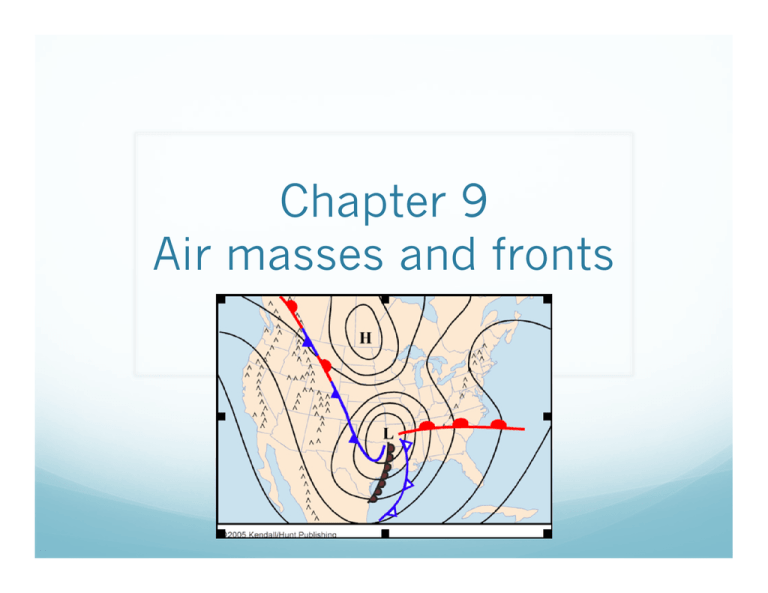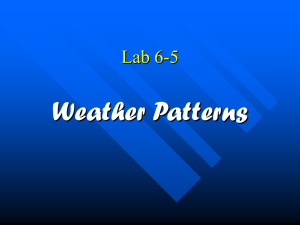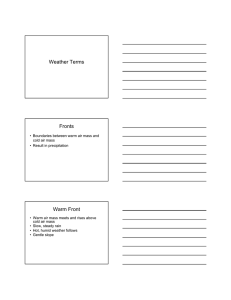Chapter 9 Air masses and fronts
advertisement

Chapter 9 Air masses and fronts What is an airmass? Airmass – a large body of air with relatively uniform thermal and moisture characteristics How large is an airmass? Area covered ~several hundred thousand square km Depth ~1-2 km up to depth of troposphere Airmasses are usually named for both their moisture and thermal characteristics (maritime tropical, continental polar, etc). Airmass characteristics Moisture characteristics Thermal (temperature) characteristics How and where to airmasses form? Sea level pressure and airmasses High sea level pressure is often associated with: Cold airmasses – Arctic and Polar Maritime airmasses in the summer (Bermuda high and Pacific high) Low sea level pressure is often associated with: Hot airmasses – Tropical Maritime airmasses in the winter (Aleutian Low and Icelandic Low) Clicker Question An airmass that is moist and cool would be called a ___________ airmass. A. Continental polar B. Continental tropical C. Maritime polar D. Maritime tropical Clicker Question You would expect a continental tropical airmass to form over the _____________. A. Gulf of Mexico B. Northern Pacific Ocean C. Desert southwest of the US D. Northern great plains of Canada Fronts Front – a boundary between different airmasses Why do we care about fronts? Recall lifting mechanisms discussion… One airmass is usually lifted up and over the other airmass along a front, resulting in the formation of clouds and precipitation. As we study different types of fronts you will want to know how the weather changes as the front passes. Front classification Fronts are classified based on: Thermal and moisture characteristics of the airmasses Direction of movement of the airmasses Whether the front is contact with the surface or is only found aloft We’ll study six types of fronts: Cold fronts and warm fronts Stationary fronts Occluded fronts Dry line Upper level fronts Front symbols on weather maps Cold fronts Cold front – a front that separates warm and cold airmasses, and the cold air is advancing and lifting the warm air Arctic front – a cold front that marks the leading edge of an advancing Arctic airmass Weather associated with a cold front: Ahead of a cold front the weather will be warm and often sunny. As the cold front passes there may be clouds and precipitation and the temperature will drop sharply. Behind the cold front the weather will often be clear and cold. Exception: Along the Colorado Front Range Fronts often have a wind direction shift associated with them, and cold fronts often shift to bring winds with an easterly component = upslope flow, clouds and precip Precipitation and cold fronts Depends on type of airmass ahead of cold front A. Warm, moist, conditionally unstable airmass Thunderstorms on leading edge of front B. Warm, moist stable airmass Widespread clouds, light precipitation along front C. Warm, dry stable airmass No clouds or precipitation Warm fronts Warm front – a boundary where the cold air is retreating and the warm air is advancing Weather associated with a warm front: Ahead of the warm front the air is cool. As a warm front approaches you will first notice high thin clouds ahead of the front. As the warm front gets closer the clouds will become lower, get thicker, and light precipitation may begin to fall. Right before the warm front passes the clouds will be very low and thick and the precipitation will be at its heaviest. Once the warm front passes the skies will clear and the temperature will warm. Precipitation and warm fronts Depends on type of airmass behind warm front A. Warm, moist conditionally unstable airmass Thunderstorms along and ahead of front (over cold air side) B. Warm, moist stable air Widespread clouds and light precipitation along and ahead of front Clicker Question The following symbol is used to indicate ____________. A. B. C. D. E. Cold front Warm front Stationary front Occluded front Dry line Clicker Question _______ clouds often form ____________ warm fronts with warm, moist and stable air behind the warm front. A. Cumulonimbus, on the leading edge of B. Cumulonimbus, along and ahead of C. Nimbostratus, on the leading edge of D. Nimbostratus, along and ahead of Stationary fronts Stationary front – a boundary that separates cold and warm airmasses, where neither airmass is advancing nor retreating Even though a stationary front is not moving the warm air can still be lifted by the front. How can this be? In a stationary front the air on the cold side flows parallel to the front, causing it to neither advance nor retreat The air on the warm side can flow toward the cold air and thus rise over the cold air or flow along the cold air and be lifted ahead of it Consider the following examples… Example: Stationary fronts Consider scenario A: Which direction is the air on the cold side of the front moving? What about on the warm side? Both parallel to the front Consider scenario B: Direction on cold side? Warm side? Warm air flowing toward the cold air can rise over it! Precipitation and stationary fronts A. When warm air flows nearly parallel to front Thunderstorm, precipitation on leading edge of front B. When warm air flows toward, and up and over cold air Widespread clouds and light precipitation over cold air side of front Occluded fronts Occluded front – a boundary between cold and colder airmasses with warm air aloft How does an occluded front form? When the cold front catches up to the warm front Warm vs cold occlusions How do warm and cold occlusions differ? Temperature behind cold front Colder than ahead of warm front (cold occlusion), warmer than ahead of warm front (warm occlusion) Temperature ahead of cold front Always warm (in warm air sector) behind warm front Temperature ahead of warm front Cold, but if warmer than behind cold front (cold occlusion) or colder than behind cold front (warm occlusion) All occlusions cause warm air to be lofted above cold air Weather and occluded fronts As a cold occluded front passes the temperature changes from cold to colder (cold front colder than ahead of warm front), and clouds are widespread. As a warm occluded front passes the temperature changes from colder to cold (cold front not as cold as ahead of warm front), and clouds are widespread. Occluded fronts often form during the mature and dissipating stages of a mid-latitude cyclone’s life cycle Dry lines Dry line – a front characterized by sharp moisture differences rather than sharp temperature differences Weather associated with a dry line: Ahead of a dry line the weather is warm and humid. As the dry line passes a line of thunderstorms may form. After the dry line passes the weather remains warm but is much less humid. What types of airmasses are associated with the dry line? Warm moist and warm dry At the same temperature moist air is less dense than dry air. Which airmass is lifted along a dry line? Warm moist airmass What types of weather are associated with the dry line? Thunderstorms! Example: Dry line scenario Upper level fronts Upper level front – an airmass boundary that is present aloft but not at the surface This type of front often separates dry air that has descended from the upper troposphere or lower stratosphere from moist air that has ascended from the lower troposphere. Weather associated with an upper level front: There is often little temperature change at the surface as an upper level front passes. A line of thunderstorms may occur as an upper level front passes. Weather and upper level fronts What types of weather are associated with an upper level front? Thunderstorms Like a dry line, but not surface based Clicker Question A ____________ separates warm and cold airmasses when cold air is retreating and warm air is advancing. A. Cold front B. Warm front C. Stationary front D. Occluded front E. Dry line Clicker Question Based on the following two surface station model reports from before and after a front has passed what type of front has passed this weather station? A. Cold front B. Warm front C. Occluded front D. Dry line Clicker Question Based on the following two surface station model reports from before and after a front has passed what type of front has passed this weather station? A. Cold front B. Warm front C. Occluded front D. Dry line




